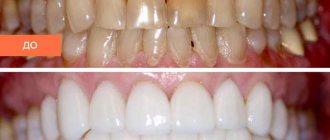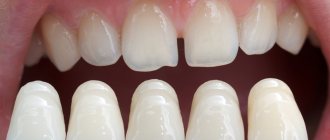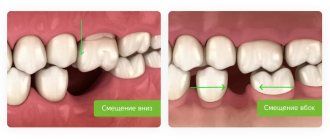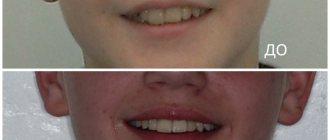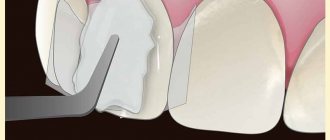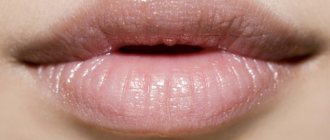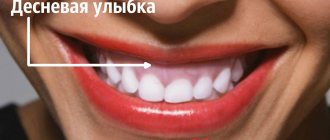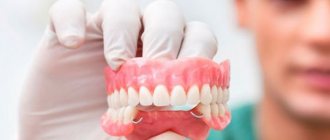If you want to improve the appearance of your smile, if you don’t like something about it, but you cannot accurately and correctly formulate what exactly, if you want to talk with your dentist about the aesthetics of your smile in the same language, then the following note is just right for you.
Nature (or God... depending on your views on life) has made us different. And our originality and uniqueness have its own charm. But what to do when this uniqueness goes too far beyond our ideas of beauty? How to formulate your claims to nature (and perhaps to the previous intervention of dentists)? To assess the aesthetic component of our face, lips, teeth - everything that gives rise to a beautiful, harmonious smile, it turns out that there are many parameters. This is what dentists use (at least should use) when planning changes in your appearance. Since there are very, very many different nuances, and I do not have the task of making each of you an expert in the field of aesthetic dentistry , we will focus on the ten simplest and most important.
Parallelism of horizontal landmarks.
One of the most important signs of a harmonious smile is the parallelism of imaginary lines: the interpupillary line (in the picture there is a blue line connecting the right and left pupil of the eye) and the lip line (in the picture there is a red line drawn between the corners of the mouth).
Both of these lines should also be parallel to the lines connecting the edges of the central incisors (green) and the incisal cusps of the canines (blue)
Gum level.
A smile looks attractive and more aesthetically pleasing , in which the line connecting the necks of the teeth (shown in dotted lines) repeats the line of the upper lip, and the level of gum exposed when smiling is symmetrical on the right and left. At the same time, with a maximally open smile, only the gum “triangles” between the teeth and a small strip of gum above them (no more than 2-3 mm wide) should be noticeable.
Thus, the gums around the upper teeth, upper and lower lips form a kind of frame for your smile. If the “picture” is not visible behind the frame, then such a smile will not look attractive.
Excessive visualization of the gums (the so-called “gummy smile”) is most often eliminated with the help of surgery, orthodontic treatment, as well as cosmetic interventions (for example, Botox injections into the upper lip, upper lip augmentation, etc.).
What is a smile?
A smile is the revitalization of the facial muscles, which shows a person’s good mood. It is a human emotion displayed on the face, in which up to fifty-three facial muscles participate.
First of all, smiling is a process that occurs in the brain. When a person smiles, certain processes are triggered in his brain. The left frontal lobe is activated, which is responsible for the emotions of happiness and joy. That is, when we smile, we feel joy and this joy is felt by the people around us, and when we rejoice, a smile appears. Its absence can become a serious barrier to communication. As a result, you need to learn to smile beautifully.
To learn to smile beautifully, first of all, you need to evaluate your own appearance.
In this video, Evgenia Bobrovskaya will show you what exercises you can use to achieve a beautiful smile:
Vertical symmetry and midline.
A line passing through the center of the face should pass exactly between the central incisors of the upper jaw. The discrepancy between these lines causes a feeling of disharmony even with a quick glance at your smile from the outside. In this case, it is not at all necessary that it also passes between the central lower incisors. Firstly, a complete match is rarely found, and secondly, this in no way affects the aesthetic perception of your smile when viewed from the outside.
Practical recommendations
- Practice in front of a mirror, achieving facial symmetry. Smile as much as possible, strengthening your muscles. After some time of intensive manipulation, the face will get used to it. The result will become obvious.
- Always try to show a radiant smile, charming those around you. Do it from the bottom of your heart with glowing eyes. Otherwise, the smile will look unnatural, implying malice.
To achieve a stunning smile, you have to work hard. Systematically perform facial exercises to strengthen your muscles. Identify all deficiencies and contact a dentist. Become a confident person, stop being shy. Having achieved a charming smile, do not stop practicing in front of the mirror, also do all the exercises.
"Golden proportion".
The principle of the golden proportion in relation to a smile in aesthetic dentistry is that when looking at it from the front strictly in the center, the ratio of the apparent width of the front teeth should be approximately the following - 0.6 (width of the canine): 1 (width of the lateral incisor): 1.6 (width of the central incisor ).
As can be seen in the photo, the width of the visible part of the remaining teeth (4s, 5s) should consistently decrease, creating a sense of perspective.
Causes of anomalies
Let's look at the main reasons why defects occur:
- Genetic factor. Mesial and distal occlusion are most often inherited. For parents, knowing about the high risk of such a defect occurring in their child, it is easier to control treatment in childhood, during the formation of the maxillofacial system.
- Developmental anomalies in the prenatal period. Various pregnancy pathologies can often affect the formation of the fetal dental system.
- Birth injury. Mesial occlusion is caused by displacement or dislocation of the baby's lower jaw during difficult childbirth.
- “Wrong” habits in childhood. These include constant pacifier or finger sucking, improper nipple latching, and improper sucking during bottle feeding. If the hole in the nipple is too large, the child’s lower jaw practically does not work when sucking and remains undeveloped.
- Frequent sinusitis and rhinitis, due to which the child constantly breathes through his mouth. With such breathing, the development of facial bones is disrupted.
- Violation of tooth change. Early removal of baby teeth often causes abnormal maxillofacial development.
- Incorrect prosthetics, lack of prosthetics.
- Hypertonicity of the masticatory muscles due to stress provokes abrasion of the incisors and displacement of the jaws.
- Various injuries of the maxillofacial area.
Proportions of the tooth.
The central incisors of the upper jaw always attract special attention, because... best visible when talking and smiling. Therefore, it is very important that their proportions are correct. The most harmonious looking teeth are those with a ratio of tooth width to length of approximately 0.7-0.8: 1
However, at different ages this ratio may change. Due to the physiological wear of teeth in older age, this ratio tends to be 1:1. Therefore, if you want to “rejuvenate” your smile, you usually need to increase the length of the tooth.
Rate your appearance
- Use your own reflection in the mirror, smile in your usual way and freeze. Soberly evaluate all the flaws in your appearance.
- Take a closer look at how much you grin and whether your gums are visible. Assess the curvature and condition of the teeth. Don't be shy in your exercises, no one is watching you.
- If visible flaws are identified, try to limit your smile to your lips, without exposing your teeth. If possible, use the services of a dentist.
- First of all, restore all the teeth if they are missing. Then, if necessary, resort to braces. After that, whiten your teeth and learn to smile properly again.
Interincisal angles.
Interincisal angles are the spaces between the cutting edges of the anterior group of teeth.
With the harmonious construction of teeth, these angles should gradually increase from the center to the periphery: from a small closed angle between the central incisors, to a more direct and even open angle between the 2nd and 3rd teeth.
Tooth wear leads to a decrease or complete absence of interincisal angles, which makes the patient look older when he smiles.
At the same time, “female” teeth are characterized by rounded corners of the incisors, while “male” teeth are characterized by straighter ones.
How to learn to smile?
- Start right now - when you read these lines: imagine a picture that causes you joy, uplifting spirit, and smile openly.
- Associate a smile with an action: say, smile every time you see yourself in a mirror or glass display case. Or when a notification about something comes to your phone.
- Try practicing metta meditation of kindness and love. It helps to awaken warm feelings towards yourself and people. This practice is done with a big smile.
- Take care of your oral and dental health so you don’t feel embarrassed to smile. By the way, chewing gum reduces stress during the working day - this has been repeatedly confirmed by scientific research.
Well, in order not just to smile, but also to communicate productively, take the Vikium online intensive “Effective Communication”. It will help you begin to better understand yourself and people, avoid misunderstandings, and succeed in establishing useful connections.
2993
Zenith of the gingival contour.
The zenith of the gum is its most concave part around the neck of the tooth (indicated by dots in the photo).
The level of zeniths near different teeth in the smile zone should be at different levels. For the central incisors and canines - approximately at the same level (or slightly higher for the canines), for the lateral incisors - slightly lower than both (as shown by the lines in the photo). At the same time, it is equally important that the zeniths on symmetrical teeth are at the same level. This is especially important to consider if this area becomes noticeable when smiling. When even with the most open smile the gums are not exposed, then there is no serious need to set the zeniths perfectly symmetrically.
In this case, attention is drawn to the too low zenith level on tooth 12; it is significantly lower than the symmetrical tooth 22. There is also a slight difference in the position of the zeniths on the central incisors (teeth 11 and 21). As a result of treatment, these shortcomings were eliminated, as can be seen in the first photo.
Why do you need to do exercises?
By strengthening your facial muscles, you will be able to freely use your facial expressions and create a sincere smile.
And sincerity can disarm any enemy, improve relations with a strict boss, and quickly conclude a business agreement.
When you feel like crying out of despair, blur out from your heart and you will feel much better. You will soon feel that your sadness is not so terrible, you will want to have fun and laugh. If you made a mistake, a shy smile will help smooth it out. Children use this technique and everything is forgiven for them.
If a person has grief or sadness, try to help him by simply smiling, encouraging, helping with advice.
Position of cutting edges.
The cutting edges of the central group of teeth are also located at different levels. For the central incisors and canines - approximately at the same level, for the lateral incisors - slightly higher (as marked by lines in the photo).
Again, due to the abrasion of teeth with age, the cutting edges of the teeth become at the same level, the line connecting them takes on a straight rather than convex appearance, and sometimes (with increased pathological abrasion) even concave. Therefore, to make a smile more “youthful,” you need to return the relationship of the cutting edges to a harmonious one.
It can also be noted that the dominance of the central incisors over the lateral incisors and canines also gives the smile a more youthful appearance.
The dominance of the canines, their sharp, prominent cutting cusps, make the smile more aggressive. This effect is based on the fact that in nature, long, sharp, well-developed fangs are characteristic of predators, whose entire philosophy of existence is based on aggression towards their prey.
Purpose of a smile
The main purpose of a smile is to express emotions. Its absence causes mistrust, since it is a means of non-verbal communication.
Basic functions of a smile:
- It inspires mutual trust;
- Smiling can convey information that cannot be conveyed in words;
- It is contagious, so you can direct the person to communicate positively with you.
When a person smiles, “fun” hormones are produced - serotonin and dopamine. He becomes more confident and calmer. A smile makes a person more resistant to stress, helps relax muscles and speeds up recovery, and if a person is sick, speeds up his recovery.
Smiling promotes the production of endorphins. Endorphins are substances that are responsible for feelings of happiness and euphoria. This substance allows you to normalize blood pressure and defeat depression.
Unlike people who frown, a person who smiles is more attractive. And people communicate with such a person, and stay away from gloomy people. Usually when you smile, your interlocutor smiles back at you. Smiling improves interaction between people, attracts positive people and increases self-confidence.
Interdental gingival papillae.
The gingival papilla is the part of the gum that fills the interdental space (marked with lines in the photo).
The location and appearance of the papillae is determined by the underlying bone, which has exactly the same contour. In the most optimal option, the tops of the gingival papillae are located as in the photo (marked with dots) - between the central incisors the gingival papilla is longest, and gradually its length decreases towards the periphery. Moreover, they should all have a healthy appearance - a triangular shape with a sharp apex, pink color, no swelling.
With various periodontal diseases, as well as with improperly performed restorations, the gingival papilla may become inflamed, acquiring a darker (or even bluish) color, losing its pointed shape, or may even disappear completely. At the same time, unaesthetic black spaces form between the teeth.
This is what the main, but still far from complete, list of parameters that need to be assessed and taken into account when planning and creating an ideal smile looks like. aesthetic dentistry does . Now you can evaluate for yourself how close your smile is to ideal. And I hope that this note will help you better understand what exactly you would like to change and improve. After all, this will greatly facilitate mutual understanding between you and your dentist.
PS See the photographs of clinical cases of my patients presented in this note in detail in the photo gallery section of the site, where details about aesthetic dentistry and modern dental technologies for restoring an ideal smile.
Pay attention to your lips
- Pay attention to the condition of your lips. First of all, they must look appropriate. Make sure your lips are always in good shape. They should not have cracks or peeling.
- Before you start smiling from ear to ear, pay the necessary attention to lip care. Use nourishing cosmetics. Take a complex of vitamins and watch your diet.
- If you naturally have thin lips, you should not highlight them with bright lipsticks. As a result of such manipulations, the appearance is unaesthetic and provocative.
- Try to highlight your lips with natural shades or visually enlarge them with the help of special pencils. Do not neglect the use of hygienic lipsticks and lip glosses in windy and cold weather.
